Drexel Unveils ‘Museum of Where We Are’ Exhibition of Design History Students’ Work
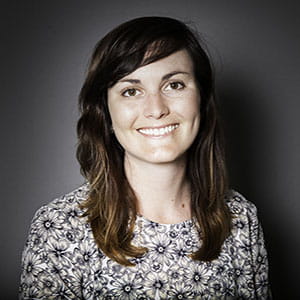 By Beth Ann Downey
By Beth Ann Downey
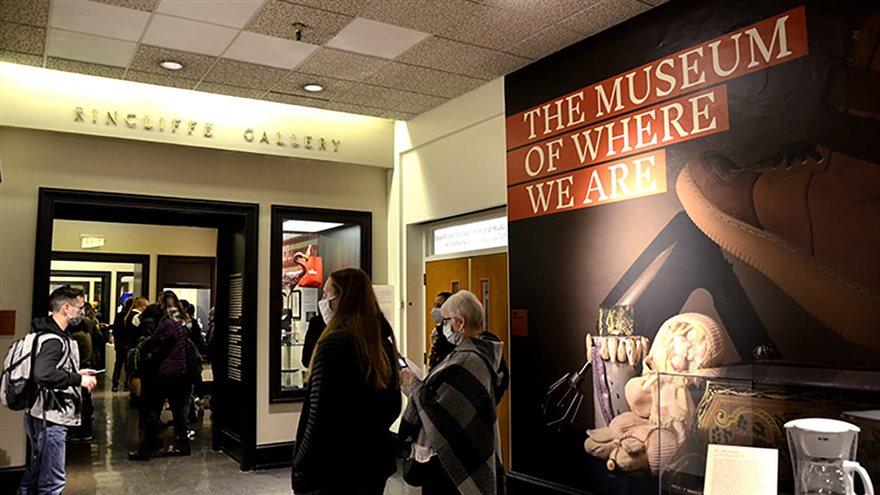
Many of us think of the objects or artworks found in a museum as above and beyond what we could contribute to the history of our world. But one Drexel University class aimed to teach students that there was beauty, stories and meaning in the everyday objects all around us — and not only that, it was time to learn about this same meaning from fellow students across the world, then put it all on display.
Joseph Larnerd, PhD, assistant professor of design history in the Westphal College of Media Arts & Design, started his “The Museum of Where We Are” online project as a way to continue facets of hands-on learning in his “ARTH 300: The History of Modern Design” class after all University coursework went remote in spring 2020 due to the pandemic.
He had students select an object from their current place of residence, and over the course of the term, conceptualize and research a label for that object like one would find in a museum. Each students’ contribution has been posted to themuseumofwhereweare.com over the course of the four terms the class has been running during the pandemic, but this past fall term, a partnership with The Drexel Collection, the University’s premiere art collection, allowed for The Museum of Where We Are to also become a physical display in the Rincliffe Gallery on Drexel’s University City Campus.
“I started this project in spring 2020. It was just me and some Squarespace tutorials. I’m so thrilled to say that this [exhibition] was far more collaborative,” Larnerd said to the crowd at an opening event for the exhibition held in the gallery on Dec. 10. “… We talk about design history being a body of knowledge, but design history is also a way of seeing and being in the world — one that helps us become more attuned to the material world and how it shapes us. I’m thrilled to say that that is just one of the many lessons that your work this quarter will impart to everyone who visits our exhibition.”
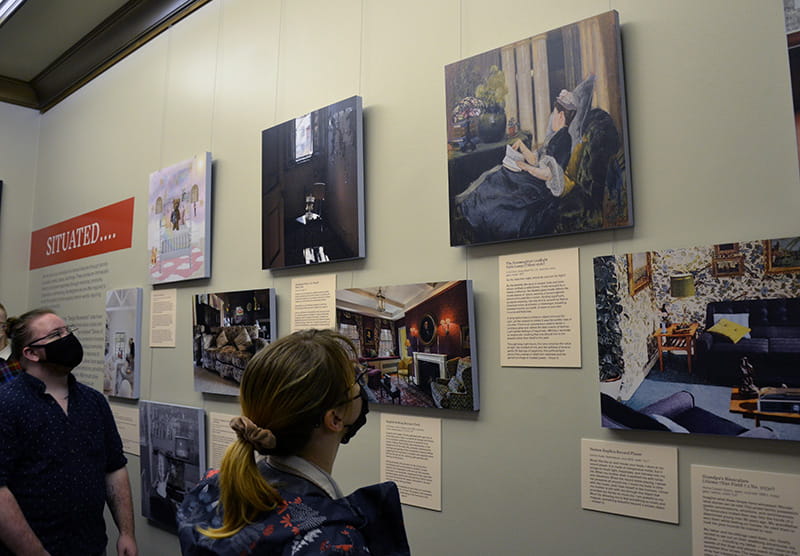
The deep collaboration found within the exhibition doesn’t only encompass what’s rooted within the Drexel community. Students in the fall 2021 iteration of ARTH 300 also worked closely with interior design students at the Collarts (Australian College of the Arts) who went through their own exercises and made their own contributions to The Museum of Where We Are. Larnerd said this global classroom came about through Drexel’s Office of Global Engagement after he received training on teaching global engagement and community engagement classes through the Lindy Center for Civic Engagement.
He was then partnered with Jenni Woods, a program coordinator of interior design at Collarts, and the two professors figured out how to host synchronous sessions, collaborate on exhibitions, and help students establish meaningful connections — all considering over half a day’s time difference.
“We took a slightly different approach because normally my students work on a project where they investigate the theory of sense of place, which is people's connection to place through memory, emotions and meaning that we create through our connection to certain places,” Woods explained. “So, my students actually interviewed somebody else about a place that was important to them, then selected an object from that place to then write their label about. They come at it from a slightly different angle to the Drexel students.”
Larnerd said his students had a real desire for this type of collaboration, as evidenced by them showing up for synchronous class meetings on Sunday night to align with Woods’ Monday class, even on Halloween.
“One of the things that grounds my own practice as a historian of material culture and as an educator is the belief that objects shape how we see ourselves, each other, and the communities to which we belong. And with that power, they shape how we think, feel and act,” Larnerd said. “And this is something that affects us, no matter where we are from — whether that's a geographical location, a class or socioeconomic background, and so on.”

Shara Saketkhou, a fifth-year product design major who took ARTH 300 this past fall, said it was a very exciting course due to its divergence from her traditional art history classes, and the fact that it was held as a global classroom.
“It gave us a good sense of universality and really grounded us in an interesting way,” she said. “These are our objects and this is our experience, and of course we learned about others’ experience through their objects and their stories. It really added such a cool universal aspect where we were able to get an experience from somebody across the world.”
There are 10 Collarts student images and labels incorporated into the Drexel Museum of Where We Are exhibition, which will be on display through March 18. Ten Drexel student labels and photos of their objects also made it into an exhibition just erected on the Collarts campus in Melbourne, Australia. Woods said she’s glad the parallel exhibitions provide a sense of connection to the work across two continents — work that she and Larnerd might soon continue.
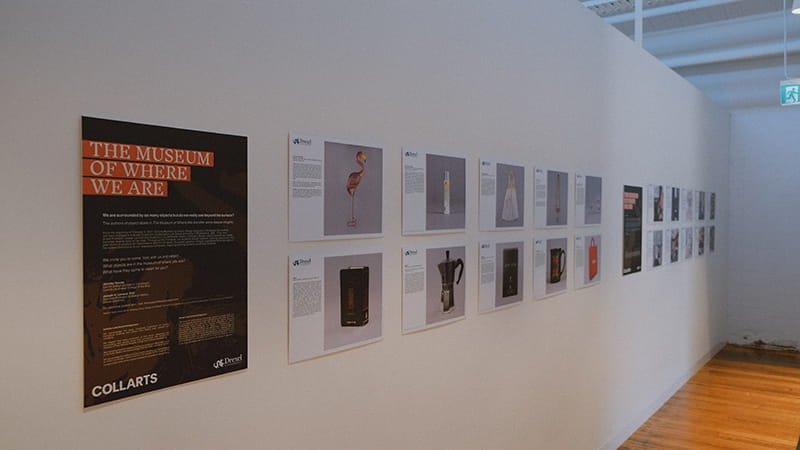
“It's been a wonderful distraction through a very trying trimester,” Woods said of the global classroom. “I can tell you, Joseph can attest to the amount of crazy things that have been happening in our part of the world over the last three months or so, with earthquakes and riots and all sorts of things. With lockdown continuing, it's been a tricky one, but I look forward to doing this in a more relaxed environment, hopefully, in the future.”
Larnerd is already working on ways to continue to animate and utilize the exhibition through March, including a docent program where two students will write and provide guided tours of the exhibit, as well as a potential collaboration with Drexel’s Writers Room. Members of the Drexel community can also stop by the gallery during their next stroll through Main Building to admire this student work, and having on display means a lot to students like Douglas Ngo, a third-year game design and production major who took the class this past term.
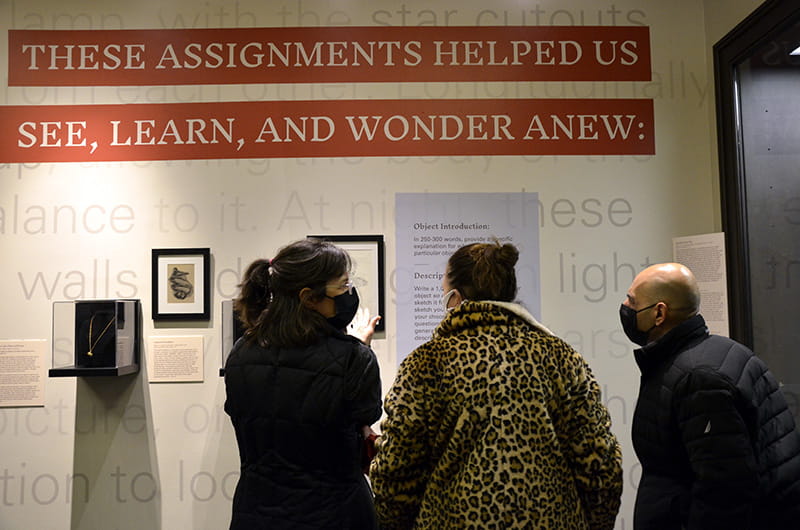
“A lot of times you do something like this with a class, especially with courses in my major, and nothing really comes from your work,” he said. “But having this in a professional exhibit is really awesome. Everyone that is here today looking through them, it really means a lot.”
Lynn Clouser Waddell, director of The Drexel Collection, was just as thrilled on Dec. 10 to have the first big opening for an exhibit in the Rincliffe Gallery in nearly two years. Though before this was able to come to fruition, she made the Collection available to students in ARTH 300 to help inform their labels.
“The goal of the Drexel Collection is to be a student resource, and give them a chance to experience hands on what the museum profession is like,” she said. “It’s not to be hidden away. We’re a little bit of everything. We try to partner with different departments and different colleges. I think this shows the range of what we can do. … This is a very different show, but it’s very exciting, and I think having students have their personal items in here allows them to connect to the Collection in ways they never would have before.”
Larnerd said he hopes the exhibition and “The Museum of Where We Are” as a whole can help students see their own place in design history, and that their work also helps make design history more inclusive.
“[This shows] students that you don't have to go to fancy museums with a lot of really expensive objects — ones owned by really rich people — to encounter meaningful design,” he said. “You can look around your apartment, you can go to a thrift store, you can go to Target, and these objects also have deep stories, meaningful stories. That's something that means a lot to me, because I know not everybody is represented in those spaces.”